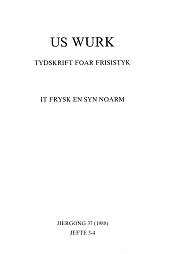Fariaasje en noarm yn 100 jier wurdboektradysje
Abstract
This article is a reappraisal of some of G. van der Woude's assertions about possible tendencies in the development of written standard Frisian during the last one hundred years. The core of these assertions is: the direction in which the standard is developing is largely determined by a) the tendency to prefer forms serving as labels of Frisianness (i.e. forms neither borrowed from Dutch - the dominant competitor of Frisian - nor resembling any Dutch word) and b) the tendency to prefer 'Clay-Frisian' forms. Appraising such vague pronouncements is extremely valuable because an insight into traditional standardisation processes is needed for further standardisation in the future.The research data have been culled from three dictionaries, i.e. products from the milieu of the 'Frisian movement’, to which we owe written Frisian and its standardisation. The interpretations of the assertions about standardisation tendencies are formally laid down in four falsifiable hypotheses; the predictions about the choice of variants (on a phonological, morphological and lexical level) may be refuted by the material. The investigation is a vindication of Van der Woude's views, though there are some differences in emphasis.

